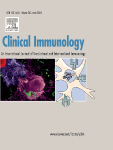
Publication date: Available online 8 September 2017
Source:Clinical Immunology
Author(s): Mengjie Wang, Jin Bu, Maohua Zhou, Jessica Sido, Yu Lin, Guanfang Liu, Qiwen Lin, Xiuzhang Xu, Jianmei W. Leavenworth, Erxia Shen
Acute myeloid leukemia (AML) is one of the most common types of leukemia among adults with an overall poor prognosis and very limited treatment management. Immune checkpoint blockade of PD-1 alone or combined with other immune checkpoint blockade has gained impressive results in murine AML models by improving anti-leukemia CD8
+T cell function, which has greatly promoted the strategy to utilize combined immune checkpoint inhibitors to treat AML patients. However, the expression profiles of these inhibitory receptors in T cells from AML patients have not been clearly defined. Here we have defined subsets of CD8
+ and CD4
+ T cells in the peripheral blood (PB) from newly diagnosed AML patients and healthy controls (HCs). We have observed increased frequencies of PD-1- and TIGIT expressing CD8
+ T cells but decreased occurrence of CD226-expressing CD8
+T cells in AML patients. Further analysis of these CD8
+ T cells revealed a unique CD8
+ T cell subset that expressed PD-1 and TIGIT but displayed lower levels of CD226 was associated with failure to achieve remission after induction chemotherapy and FLT3-ITD mutations which predict poor clinical prognosis in AML patients. Importantly, these PD-1
+TIGIT
+CD226
−CD8
+T cells are dysfunctional with lower expression of intracellular IFN-γ and TNF-α than their counterparts in HCs. Therefore, our studies revealed that an increased frequency of a unique CD8
+ T cell subset, PD-1
+TIGIT
+CD226
−CD8
+ T cells, is associated with CD8
+T cell dysfunction and poor clinical prognosis of AML patients, which may reveal critical diagnostic or prognostic biomarkers and direct more efficient therapeutic strategies.
http://ift.tt/2vVKvlx
